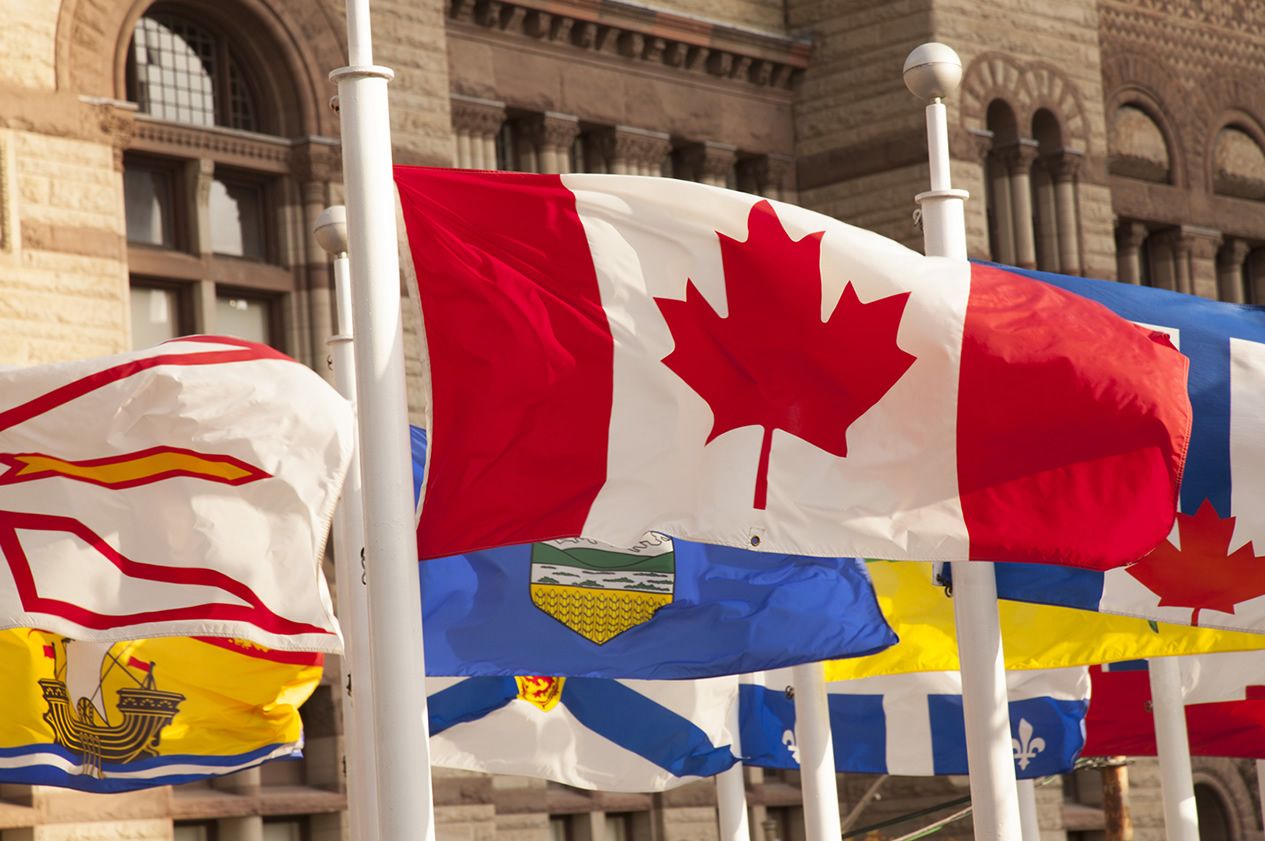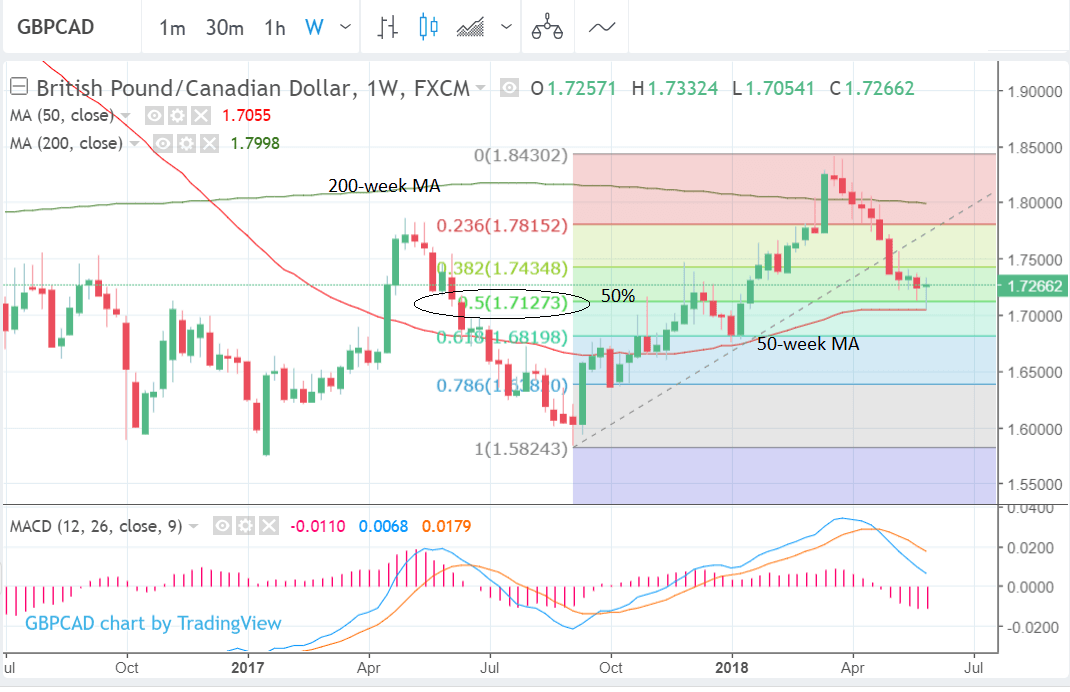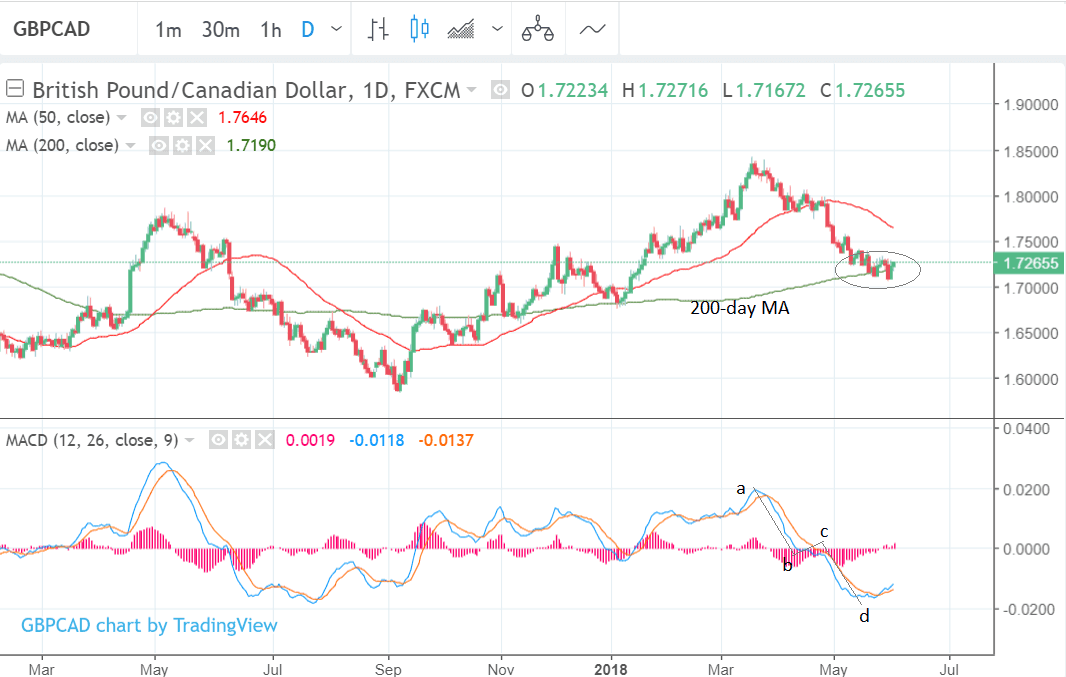Pound-to-Canadian Dollar Rate Week Ahead: Stronger, but too Early to Speculate About a Recovery

Images © Viv Idrange, Adobe Stock
GBP/CAD starts the new week more-or-less where it ended the previous week - around the 1.7290 marker - with both Sterling and the Canadian Dollar rising against the U.S. Dollar thanks to a more optimistic feel to global financial markets.
From a technical perspective, the Pound-to-Canadian Dollar rate looks to be establishing a floor under its recent run of weakness at around the 1.71 level, from which it is currently bouncing.
However, the rebound is not strong enough yet to suggest a reversal of the downtrend.
The pair has been in a bear trend after touching the 1.8000 level in April; then it met a band of support in the 1.71s and bounced back.
The weekly chart below shows the support levels in the 1.71s more clearly. They are comprised of the 50-week MA at 1.7055 and the 50.0% Fibonacci retracement at 1.7127.
The 50% retracement is essentially the midpoint of the previously rally and is said by technical analysts to have important support properties - and research does seem to bear this out: it is often the location of resumptions of the dominant trend higher, or at the very least corrective rebounds.
The daily chart below shows how the downtrend since the April highs has also met the 200-day MA at 1.7190 and consolidated (circled).
This is classic behaviour from price action - when prices touch large MAs they often stall even if they have been trending quite strongly. Sometimes they even reverse.
The reasons why are complex but have to do with a higher proportion of traders using these levels as decision making tools and therefore greater volatility in supply and demand dynamics around them.
The MACD momentum indicator in the bottom panel also looks bullish, as it is turning up after looking like it has completed a three wave zig-zag or abcd pattern lower.
Despite all the support in the 1.71s, the bounce has been insufficient to reverse the trend, and the hitherto dominant downtrend remains intact.
As such we still see the probabilities, on balance, as favouring a continuation lower, on the condition that the exchange rate can cleanly break below the 200-day and 50-week MAs, signalled by a move below 1.6990 to an initial target at 1.6900.
Advertisement
Get up to 5% more foreign exchange by using a specialist provider to get closer to the real market rate and avoid the gaping spreads charged by your bank when providing currency. Learn more here.
Week Ahead: CAD
The Canadian Dollar's week ahead will first and foremost be tied to headlines pertaining to the emerging trade war between the U.S. and the rest of the world. We saw that when the U.S. announced Canada, Mexico and the E.U. were to intact have tariffs placed on their steel and aluminium exports, the Canadian Dollar was one of the biggest losers.
This is largely down to markets believing a good outcome to the ongoing NAFTA negotiations is unlikely, and it has been these NAFTA negotiations that have been important for CAD movements of late.
In particular, we await Canada's retaliatory moves, and we would certainly expect the U.S. to respond once more.
The calendar is fairly empty, with the main data release falling on the last day of the week.
Wednesday, June 6: It could be worth watching the trade balance release for April, out at 13:30 B.S.T where market consensus is forecasting a reading of -2.24BN. Should the trade balance improve, it could be taken as a signal that the underlying trade position is heading in a direction consistent with a more robust CAD.
The Ivey PMI data for May is out at 15:00 B.S.T. This is second-tier data that is unlikely to shake CAD, and as of yet we don't have a consensus estimate for the event, instead, we will be looking for a beat or miss on the previous month's 71.5.
Friday, June 8: We have employment data out at 13:30 B.S.T. Markets are looking for the headline employment change to read at 17.4K in May, a big improvement on April's -1.1K.
A beat on expectations would certainly provide CAD with some relief ahead of the weekend as it would suggest that the Bank of Canada was right to deliver a 'hawkish' message at their May policy meeting.
The Bank of Canada held its cash rate steady at 1.25% for the month of June but tweaked the language of its statement enough to leave a hawkish taste in the mouth of the market, which prompted traders to bid the Loonie higher.
Strong employment data will keep this theme alive.
Week Ahead: GBP
Monday, June 4: Construction PMI for May, consensus forecast is for 51.9, the previous month read at 52.5.
Typically the construction PMI is ignored by markets, but owing to the slowdown we saw at the start of the year, and a focus on future Bank of England policy, foreign exchange markets will be paying more attention to this release than normal.
They will be looking for a clear sign that growth in this sector - a sector that has struggled over recent months - is back. A beat on expectations could help Sterling, a miss will likely weigh on the currency.
Tuesday, June 5: Services PMI for May, consensus forecast is for 53.1, up on April's 52.8.
The services sector accounts for over 80% of UK economic activity and it is therefore no wonder this is likely to form the highlight for Sterling in the coming week.
Thursday, June 7: We get a slew of house price data which is unlikely to hurt or help Sterling. Nevertheless, surprises will catch some attention. The RICS house price balance is forecast to deliver a reading of -1% and the Halifax house price index is forecast to show a reading of 1% on a month-on-month basis.
Friday, June 8: Industrial and manufacturing production numbers are on the docket. Consensus forecasts for industrial production for April is at 3.1% on an annualised basis, up from the previous month's 2.9%.
Consensus forecasts for manufacturing production are for -0.2% for April on an annualised basis, down on the previous month's -0.1%.
With sentiment towards Sterling rather dreary on the economic front we would suggest the risk-reward ratio lies to the upside, as positive surprises tend to deliver the greatest impact when consensus is poor. In short, bad economic news is largely in the price of Sterling.
Advertisement
Get up to 5% more foreign exchange by using a specialist provider to get closer to the real market rate and avoid the gaping spreads charged by your bank when providing currency. Learn more here.





